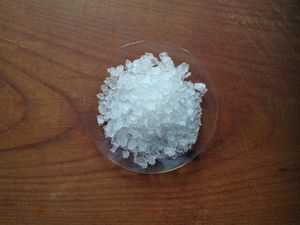Zinc sulfate
 |
This article is a stub. Please help Sciencemadness Wiki by expanding it, adding pictures, and improving existing text.
|
 Zinc sulfate obtained by reducing CuSO4 with Zn metal
| |
| Names | |
|---|---|
| IUPAC name
Zinc sulfate
| |
| Other names
Goslarite
White vitriol Zinc(II) sulfate | |
| Properties | |
| ZnSO4 | |
| Molar mass | 161.47 g/mol (anhydrous) 179.47 g/mol (monohydrate) 287.53 g/mol (heptahydrate) |
| Appearance | White solid |
| Odor | Odorless |
| Density | 3.54 g/cm3 (anhydrous) 2.072 g/cm3 (hexahydrate) |
| Melting point | 680 °C (1,256 °F; 953 K) decomposes (anhydrous) 100 °C (212 °F; 373 K) (heptahydrate) 70 °C (158 °F; 343 K) decomposes (hexahydrate) |
| Boiling point | 740 °C (1,360 °F; 1,010 K) (anhydrous) 280 °C (536 °F; 553 K), decomposes (heptahydrate) |
| anhydrous 57.7 g/100 mL (25 °C) 101 g/100 ml (70 °C) | |
| Solubility | Insoluble in ethanol, toluene |
| Thermochemistry | |
| Std molar
entropy (S |
120 J·mol−1·K−1 |
| Hazards | |
| Safety data sheet | LabChem (heptahydrate) |
| Related compounds | |
| Related compounds
|
Cadmium sulfate Mercury(II) sulfate |
| Except where otherwise noted, data are given for materials in their standard state (at 25 °C [77 °F], 100 kPa). | |
| Infobox references | |
Zinc sulfate (also known as white vitriol) is the inorganic compound with the chemical formula ZnSO4. It is a common source of the zinc ion, and is colorless and water soluble.
Contents
[hide]Properties
Chemical
Zinc sulfate will react with sodium carbonate to yield sodium sulfate and zinc carbonate.
At temperatures over 680 °C, zinc sulfate decomposes to yield sulfur trioxide gas and zinc oxide fumes.
Physical
Zinc sulfate is a white hygroscopic solid. It is soluble in water and some alcohols. It forms three hydrates.
Availability
Zinc sulfate heptahydrate can be found in nature as the mineral known as goslarite.
Zinc supplements generally contain zinc sulfate, usually mixed with vitamins or sweeteners and are available at pharmacies.
Lastly, it can also be bought from chemical suppliers.
Preparation
A simple way to make zinc sulfate is to react sulfuric acid with zinc metal.
Zinc sulfate can be prepared by adding zinc metal to a solution of copper(II) sulfate. Metallic copper sponge will precipitate (with small amounts of copper(II) oxide and copper(I) oxide) and the solution will become colorless when the reaction stops. The filtered solution can be boiled to crystallize the zinc sulfate from the solution.
Projects
Handling
Safety
Zinc sulfate has low toxicity and is also sold as a supplement. It's best to avoid consuming lab-grade ZnSO4 though, as it may contain traces of heavy metals (cadmium e.g.). Anhydrous zinc sulfate may cause irritations.
Storage
The anhydrous form should be stored in closed bottles to prevent hydration. Otherwise there are no special procedures needed.
Disposal
If not contaminated with heavy metals or other toxins, it can be safely dumped in the ground or down the drain.
You can also recover the zinc metal through electrowinning. The leftover acidic solution should be neutralized before disposal.